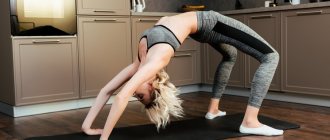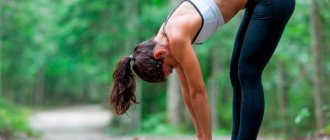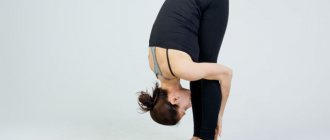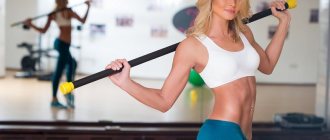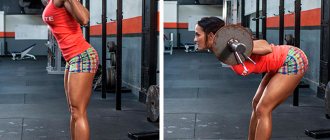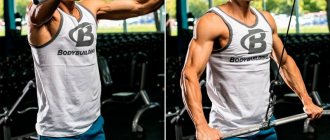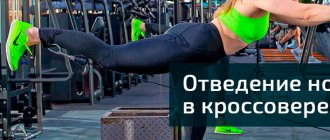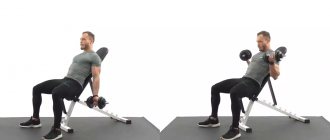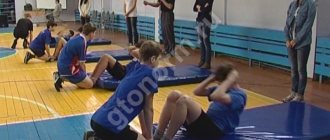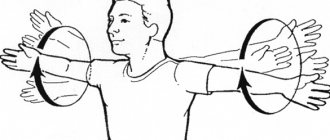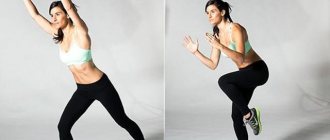GTO standards for the test “Bending forward from a standing position with straight legs on a gymnastic bench”
| Stage (age) | Boys/Men | Girls/Women | ||||
| Bronze | Silver | Gold | Bronze | Silver | Gold | |
| Stage I (6-8 years) | +1 | +3 | +7 | +3 | +5 | +9 |
| II stage (9-10 years) | +2 | +4 | +8 | +3 | +5 | +11 |
| III stage (11-12 years) | +3 | +5 | +9 | +4 | +6 | +13 |
| IV stage (13-15 years) | +4 | +6 | +11 | +5 | +8 | +15 |
| V stage (16-17 years old) | +6 | +8 | +13 | +7 | +9 | +16 |
| VI stage (18-24 years old) | +6 | +8 | +13 | +8 | +11 | +16 |
| VI stage (25-29 years old) | +5 | +7 | +12 | +7 | +9 | +14 |
| VII stage (30-34 years) | +3 | +5 | +11 | +5 | +7 | +13 |
| VII stage (35-39 years) | +2 | +4 | +10 | +4 | +6 | +12 |
| VIII stage (40-44 years) | +1 | +3 | +9 | +2 | +4 | +11 |
| VIII stage (45-49 years) | 0 | +2 | +8 | +2 | +4 | +10 |
| IX stage (50-54 years old) | -1 | +1 | +7 | +1 | +3 | +9 |
| IX stage (55-59 years old) | -2 | 0 | +5 | +1 | +3 | +8 |
| X stage (60-64 years old) | -6 | -4 | -1 | 0 | +2 | +6 |
| X stage (65-69 years) | -8 | -6 | -4 | -4 | -1 | +2 |
| XI stage (70 years and older) | -10 | -8 | -6 | -6 | -4 | 0 |
GTO standards for the test 'Bending forward from a standing position with straight legs on a gymnastic bench' - expand
GTO standards for the test 'Bending forward from a standing position with straight legs on a gymnastic bench' - collapse
Why do it?
Leaning your torso forward is a completely natural movement for the human body. Performing the exercise does not require any physical training or sports equipment. It is ideal for independent training at home.
Effect on the body:
- Forward bending of the torso improves the flexibility of the spine and the mobility of the hip joints.
- There is a training session to stretch the hamstrings and muscles of the back of the thighs. Especially if you do the exercise with straight legs.
- Strengthening the muscles of the abs, back, buttocks.
- Improving blood circulation, preventing vascular diseases of the head.
How to perform and measure results
The exercise is performed in two different ways - standing on the floor and on a gymnastic bench. In the first case, you can measure only two degrees of flexibility - touching the floor with your fingertips or pressing your palms to the floor. In this case, the result is influenced by the anatomical characteristics of each subject. This method is not accurate, but it is less traumatic, does not require additional equipment and allows you to practice independently, without an assistant or trainer.
Performing the exercise while standing on a gymnastic bench allows for more accurate measurements. Flexibility is measured using a ruler that the subject touches while bending. The measurement is made in centimeters and is indicated by a “+” sign if the fingertips go below the bench level and a “-” sign if above the bench level. Negative values can be measured using a ruler and when performing the exercise while standing on the floor.
It is recommended to perform exercises on a gymnastic bench for subjects aged 15 to 39 years, and on the floor for subjects of other ages.
Contraindications
To be fair, it is worth noting that bending forward from a standing position, like any other exercise, has contraindications. Essentially, they are associated with two features of the movement: the inverted position of the body and the impact on the spine. In some conditions of the body these effects are undesirable:
- High blood pressure, headaches, vascular diseases of the head.
- Problems with the spine, for which tension of the muscles of the lumbar region is not recommended.
Often, in case of problems with the spine, it is recommended not to bend over from a standing position, but to raise the pelvis from a squatting position, while leaving the arms below. Due to this, the position when the body is parallel to the floor is excluded from the exercise. It is this pose that requires maximum tension in the lower back muscles. After all, when you have already bent over, the back muscles are relaxed.
Types of exercise
Having mastered how to bend forward correctly, you can increase the load by using additional weights : a barbell, a barbell, dumbbells.
Another effective variation of the exercise for working the muscles is bending forward from a sitting position. This exercise came to fitness from the world of yoga, where it is known as Paschimottanasana asana. It is also popularly called the “fold.”
This exercise is good to use as a warm-up at the end of a workout. Then its effectiveness will increase, since warmed muscles stretch better. The technique for performing this exercise is as follows:
- You need to sit down on your buttocks and straighten your legs in front of you. Pull your socks out and point them towards you. Press your shins to the floor surface.
- As you exhale, bend forward slightly, keeping your back straight. Use your palms to grab your knees or shins.
- Using your hands, start moving forward. Your task is to stretch the spine behind the crown up and forward. Try not to round your back, otherwise the exercise will not bring any benefit.
- Now relax, as you exhale, press your stomach as close to your legs as possible, as if bending in half. Stretch forward with the top of your head. When performing a forward bend while sitting, you do not need to strain your shoulders and hold your breath. Try to hold this position for 30-60 seconds. With a little practice, you can maintain this position for a couple of minutes.
- You need to get out of this pose correctly. Movements should be slow. Several breathing cycles should come out. Move your lower back slightly back, lift your head and bend slightly towards your chest and back. Slowly rise up, gradually, so that your back is eventually at a right angle to the floor.
Execution technique
Despite the popularity of the exercise, the technique for performing it has its own characteristics. Let's take a closer look at it.
- Stand up straight, place your feet shoulder-width apart, straighten your back. The lower back should maintain a natural arch, and the chest should be straightened.
- Tighten your abs and, keeping your back straight, lower your body down, rotating at the hip joints. If your current level of flexibility does not allow you to reach the floor with your hands, do not round your back, but bend your knees slightly. Flexibility will develop over time, and you will be able to fully perform a forward bend with straight legs.
- Hold at the bottom point for 1-2 seconds and, using the force of the gluteal muscles, return to the starting position. Perform the required number of repetitions.
Always focus on the fact that you are not pulling your body up using your back muscles. This is not only wrong, but also dangerous. The back muscles keep the body in a straight position, and the gluteal muscles lift it.
Also, when bending your torso forward, you should pay attention to breathing. Experts have different opinions on this matter. The simplest and safest option is to adhere to the anatomical features of the human body. Namely, in a standing position, the chest is straightened, the lungs can accommodate a sufficient volume of air. At the lowest point, it's the other way around. Therefore, it is logical to lower the body as you exhale and lift it as you inhale.
https://www.youtube.com/watch?v=VxQsvDHAKtM
You can start by performing 10-15 bends in 2-3 approaches. The exercise should be done at a slow pace, without jerking, and completely under control. Strive to lower yourself from a standing position to a bend with your legs straight.
Bends forward from a standing and sitting position
It would seem, What could be simpler than tilting? But as the Russian proverb says, “Don’t say gop until you jump over.”
In fact, bending over is a fairly difficult exercise. There are more than 40 types of this exercise in the world, but in this article we will talk about the most effective of them. We will talk about bending forward with closed legs.
Bend forward from a sitting position at school, legs together (cm) | ||||||
| Boys | Class | Girls | ||||
| 5 | 4 | 3 | 5 | 4 | 3 | |
| +6 | +3 | +1 | 1 class | +7 | +5 | +3 |
| +7 | +4 | +2 | 2nd grade | +8 | +6 | +4 |
| +8 | +5 | +3 | 3rd grade | +9 | +7 | +4 |
| +9 | +6 | +4 | 4th grade | +10 | +8 | +5 |
| +10 | +8 | +6 | 5th grade | +12 | +8 | +5 |
GTO Bend forward from a standing position with straight legs on a gymnastic bench
The GTO program provides for passing standards in all age categories, and this is an indicator of the importance of this exercise in a person’s healthy lifestyle
| Boys | GTO Bend forward from a standing position with straight legs on a gymnastic bench (from the level of the bench - cm) | Girls | ||||
| +1 | +3 | +7 | 1st stage (6-8 years) | +3 | +5 | +9 |
| +2 | +4 | +8 | Level 2 (9-10 years) | +3 | +5 | +11 |
| +3 | +5 | +9 | Level 3 (11-12 years old) | +4 | +6 | +13 |
| +4 | +6 | +11 | Level 4 (13-15 years old) | +5 | +8 | +15 |
| +6 | +8 | +13 | Level 5 (16-17 years old) | +7 | +9 | +16 |
| Men | Women | |||||
| +6 | +8 | +13 | Level 6 (18-24 years old) | +8 | +11 | +16 |
| +5 | +7 | +12 | Level 6 (25-29 years old) | +7 | +9 | +14 |
| +3 | +5 | +11 | 7th stage (30-34 years old) | +5 | +7 | +13 |
| +2 | +4 | +10 | 7th stage (35-39 years old) | +4 | +6 | +12 |
| +1 | +3 | +9 | 8th stage (40-44 years old) | +2 | +4 | +11 |
| 0 | +2 | +8 | 8th stage (45-49 years old) | +2 | +4 | +10 |
| -1 | +1 | +7 | 9th stage (50-54 years old) | +1 | +3 | +9 |
| -2 | 0 | +5 | 9th stage (55-59 years old) | +1 | +3 | +8 |
| -6 | -4 | -1 | 10th stage (60-64 years old) | 0 | +2 | +6 |
| -8 | -6 | -4 | 10th stage (65-69 years old) | -4 | -1 | +2 |
| -10 | -8 | -6 | 11th stage (70+ years) | -6 | -4 | 0 |
Video:
Why do we need forward bends: firstly, they tone our muscles, and secondly, they develop flexibility. And this is only a small part of their potential. Although the technique itself is quite simple, it requires compliance with some nuances. Since bending forward with closed legs is a warm-up exercise, its benefits for the body are invaluable, and due to the fact that it does not require special training or equipment, it can be freely included in a set of home exercises. Forward bending affects our body in the following ways:
- Makes our spine more flexible and joints mobile, preventing arthritis, osteochondrosis and osteoporosis.
- Improves blood circulation, thereby reducing the risk of strokes and heart attacks.
- The tendons become elastic due to periodic stretching.
- The abdominal muscles, gluteus maximus, and quadratus lumborum muscles are trained.
To perform this exercise correctly, it is important to adhere to the following technique. Firstly, you need to stand up straight with your back straight, feet together, the arch of the lower back should be sufficiently natural without any curvature. Secondly, take a breath and, tensing your abdominal muscles, smoothly (without strain) lower your body down until your toes touch the floor or the tips of your legs. If you lack flexibility, you can bend your knees slightly. This will make the exercise easier. After all the actions done, you need to stay in this position for a couple of seconds, and while exhaling, return to the starting position.
When performing a torso raise, it is important to remember that it is done by the gluteal muscles. If you perform this movement using your back extensors, you can get seriously injured. For beginners in this exercise, only two or three approaches 10-15 times a day are required to achieve good results after just a month of training. As for breathing techniques, it should be set according to the anatomical characteristics of each person.
What are the contraindications?
Despite the obvious benefits, bending forward has a number of contraindications such as:
- spinal injuries;
- acute pulmonary failure;
- cholesterol plaques in blood vessels;
- displacement of intervertebral discs;
- advanced forms of arthritis;
- allergy;
- pregnancy and lactation;
- oncological diseases;
- atrial fibrillation;
- spinal hernia;
- hypertensive and hypotensive crises.
because, like most similar exercises, forward bends came to us from yoga. Therefore, the approach to this exercise must be true to its origins. Under no circumstances should you rush. The movement should be smooth. Jerks are not allowed. Breathing should be smooth and constant. Keep your feet straight and turn your heels inward. Do not help yourself too much with your hands as this can lead to back injuries.
Once athletes have achieved sufficient flexibility, they can use weights. At home, these can be bottles filled with water. While in the gym, take dumbbells and try to bend over with them. Select the weight of the weights according to your capabilities.
As a result, if all recommendations and safety measures are strictly followed, after a week of training the results will not be long in coming.
| +1 | +3 | +7 | 1st stage (6-8 years) | +3 | +5 | +9 |
| +2 | +4 | +8 | Level 2 (9-10 years) | +3 | +5 | +11 |
| +3 | +5 | +9 | Level 3 (11-12 years old) | +4 | +6 | +13 |
| +4 | +6 | +11 | Level 4 (13-15 years old) | +5 | +8 | +15 |
| +6 | +8 | +13 | Level 5 (16-17 years old) | +7 | +9 | +16 |
| Men | Women | |||||
| +6 | +8 | +13 | Level 6 (18-24 years old) | +8 | +11 | +16 |
| +5 | +7 | +12 | Level 6 (25-29 years old) | +7 | +9 | +14 |
| +3 | +5 | +11 | 7th stage (30-34 years old) | +5 | +7 | +13 |
| +2 | +4 | +10 | 7th stage (35-39 years old) | +4 | +6 | +12 |
| +1 | +3 | +9 | 8th stage (40-44 years old) | +2 | +4 | +11 |
| 0 | +2 | +8 | 8th stage (45-49 years old) | +2 | +4 | +10 |
| -1 | +1 | +7 | 9th stage (50-54 years old) | +1 | +3 | +9 |
| -2 | 0 | +5 | 9th stage (55-59 years old) | +1 | +3 | +8 |
| -6 | -4 | -1 | 10th stage (60-64 years old) | 0 | +2 | +6 |
| -8 | -6 | -4 | 10th stage (65-69 years old) | -4 | -1 | +2 |
| -10 | -8 | -6 | 11th stage (70+ years) | -6 | -4 | 0 |
The benefits of bending
Not only is bending over a great stretch, but by holding it for long enough—about a minute—it can help your body enter a “rest and digest” mode, which can help you relax, relieve stress, and even maintain a healthy weight.
“The first thing that comes to mind when we gain weight is that we need to change our diet and increase cardio,” says Swart. – But often this is a signal from the body: the stress hormone is trying to “save” us by holding on to belly fat. And to get rid of it, it is important to regularly do exercises that reduce stress levels.”
What's the point
In a nutshell, bending forward switches the nervous system from sympathetic to parasympathetic. “The sympathetic nervous system means fight or flight.” We are in this state during stressful situations,” says Swart. – The mobilization hormone cortisol is constantly released, which blocks immunity and tissue regeneration. Blood flow from the gastrointestinal tract decreases, pulse and pressure increase, and other unpleasant symptoms appear.”
If the danger has passed, the body launches the parasympathetic nervous system, which is responsible for rest and digestion. The body and brain quickly move into a calm state. The longer it lasts, the better the person's health.
In the fold pose, the head is lowered below the level of the heart, this pose calms the mind, relieves stress and even helps with headaches. It also improves digestion!
